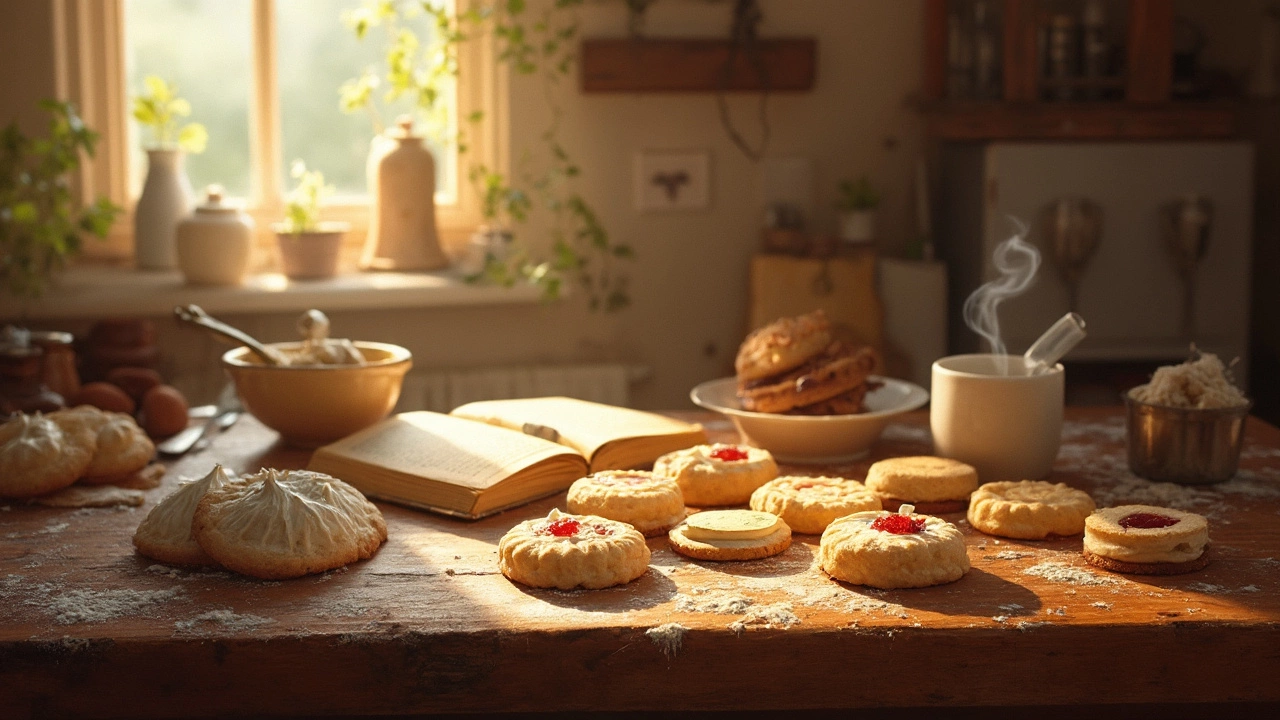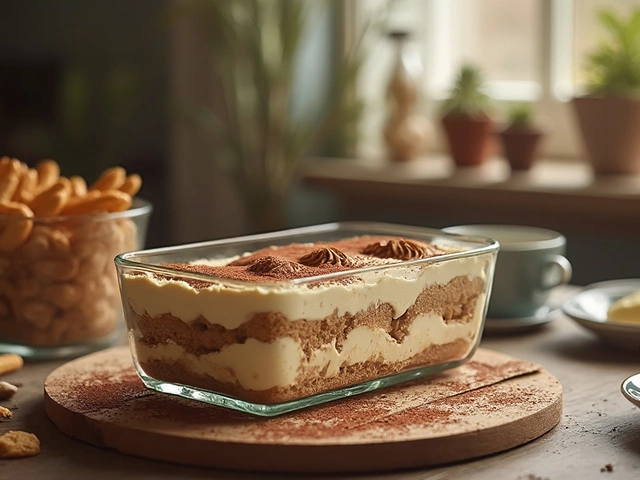Baking cookies at home can be as simple or as elaborate as you want it to be. Whether you're aiming for the gooey center of a chocolate chip delight or the crisp edges of a snickerdoodle, understanding the basics is key. First off, let's talk ingredients. Each one plays a specific role in the outcome, so it's worth understanding how they react together.
Take butter and sugar for instance. Creaming these together not only incorporates air for a fluffy texture but also sets the stage for the entire dough. Eggs follow - they bind everything together, add richness, and can even affect the color of your cookies. And don't forget about your flour. All-purpose is a safe bet for most cookie recipes, but subbing a portion with cake flour can yield a softer cookie. Who knew baking involved this much chemistry?
- Understanding Your Ingredients
- Mixing Mastery
- The Art of Rolling and Cutting
- Baking Perfection
- Creative Variations
- Storing and Enjoying
Understanding Your Ingredients
When it comes to making homemade cookies, knowing your ingredients inside out can make all the difference. Each component in your recipe has a purpose, shaping the texture, flavor, and appearance of your cookies.
Butter and Fats
Butter is crucial for that tender, melt-in-your-mouth quality. It can affect both the texture and flavor. Want a cookie that spreads nicely? Use melted butter. If you like them thick and chewy, go for softened butter. Margarine or shortening can be used as alternatives, but remember, they lack the rich flavor butter brings.
Sugars
Sugar doesn't just sweeten; it plays a role in spreading and browning. Granulated sugar flattens and crisps cookies, while brown sugar adds moisture and chewiness due to its molasses content. For a balanced cookie baking experience, many recipes mix the two.
Flour and Raising Agents
Flour gives structure. The type you use impacts cookie softness and spreadability. All-purpose flour is the go-to for most recipes, but tweaking with cake flour can make for a lighter bite. Baking soda and baking powder are leaveners. While baking soda is great for spreading, baking powder puffs cookies up.
Add-ins
Cookie recipes are infinitely customizable. Chocolate chips, nuts, dried fruits - you name it! Not only do these add flavor and texture, but they also provide visual appeal.
Here’s a handy breakdown of the main ingredients and their average use per batch of cookies:
| Ingredient | Average Amount |
|---|---|
| Butter | 1 cup (2 sticks) |
| Granulated Sugar | 1 cup |
| Brown Sugar | 1 cup |
| Eggs | 2 large |
| All-purpose Flour | 2-3 cups |
Master these basics, and you're on your way to perfect baking cookies every time.
Mixing Mastery
Mixing might seem like the easiest part of baking, but it can make or break your homemade cookies. Get it right, and you're on your way to cookie perfection.
Tools and Techniques
Start with the right tools. A sturdy hand mixer or stand mixer is your best bet. These can help you achieve the perfect creaminess, especially when working with butter and sugar.
Once your ingredients are ready, focus on creaming the butter and sugar until it's light and fluffy. This usually takes about 3-4 minutes on medium speed. You want it to resemble a creamy frosting – that's how you know it's well mixed.
Order Matters
Follow the order of ingredients carefully. Dry ingredients like flour, baking soda, and salt should be mixed separately and added gradually to the wet mixture. This avoids clumps and ensures even distribution, which is crucial for consistent texture and flavor.
- Prepare Wet Ingredients: Once your butter and sugar are creamed, add eggs one at a time. Mix well after each addition.
- Combine Dry Ingredients: Mix flour, baking soda, and salt in a separate bowl.
- Gradual Integration: Add dry ingredients to the wet mix slowly, preferably in thirds. Mix until just combined to avoid overmixing, which can lead to tough cookies.
The Importance of Temperature
Your ingredients should be at room temperature unless otherwise specified. Butter's consistency is crucial for creaming. Cold ingredients can lead to a denser dough, while too warm butter can make your mixture too oily.
A study found that room temperature butter gives cookies a 20% better rise and texture compared to overly softened or melted butter. So, don't skip this step!
Mastering these cookie baking tips can save you from that dreaded "too hard" or "too flat" cookie fate. Once you perfect your mixing skills, the rest is a piece of cake—or should I say, a cookie!
The Art of Rolling and Cutting
Once your dough is mixed and ready, the next step in crafting those irresistible homemade cookies is mastering the art of rolling and cutting. Getting this part right can be the difference between cookies that are perfectly uniform and those that are irregular or, worse, tough and chewy.
Chilling the Dough
Start by chilling your dough. This step is crucial! Chilling makes the dough less sticky and easier to handle, and it also prevents excessive spreading during baking. Pop it in the fridge for at least 30 minutes or until it's firm. For those planning ahead, you can prepare and chill your dough a day earlier.
Rolling the Dough
When rolling out your dough, dust both your rolling pin and surface lightly with flour to prevent sticking. Roll from the center outward rather than back and forth, rotating the dough occasionally to ensure even thickness. Most recipes suggest a thickness of about 1/4 inch for ideal cookies.
Cutting Shapes
To cut out shapes, choose cookie cutters of your preferred style. Press firmly to ensure clean edges and minimize wasted dough. Tip: To keep intricate shapes from distorting when transferring to a baking sheet, try lifting them with a spatula.
Using Scraps Smartly
Combine leftover scraps gently and roll them out again. Try not to over-handle as this can make the dough tough. It's all about balance—you want to get the most cookies possible without sacrificing quality.
With these techniques mastered, you'll find your cookie baking ventures not only more successful but also more fun. Happy baking!

Baking Perfection
Getting that perfectly baked cookie is a fine art that blends timing, temperature, and keen observation. Every cookie requires its own sweet spot, depending on its size and thickness, so mastering this can instantly level up your baking game.
Know Your Oven
First things first, trust but verify. Ovens can be a little tricky because not all of them heat evenly. Invest in a good oven thermometer to keep track of the actual temperature inside. This little tool can save you from underbaking or overbaking your cookies. For most cookies, setting the oven to 350°F (175°C) is a safe bet, but double-check your specific recipe when in doubt.
Consider the Rack Position
The position of your oven rack may seem trivial, but it actually makes a world of difference. Use the middle rack for an even circulating heat, which helps in creating cookies with those golden edges and soft centers. If you’re making multiple batches, rotate your baking sheets halfway through to ensure even baking.
Timers Are Your Best Friend
Baking times can vary. It’s crucial to set a timer but also rely on your senses. Most cookies should be slightly golden around the edges, while the center might look a tad underbaked when you first take them out. That's perfect because they continue to firm up on the baking sheet as they cool.
Cooling Matters
Letting cookies cool on the baking sheet for about 2-3 minutes before transferring them to a wire rack is key. This allows the cookies to set and helps prevent them from falling apart. The wire rack promotes air circulation, which is amazing for cooling them evenly.
Keep these tips in mind and you'll be on your way to achieving that elusive cookie baking perfection. Remember, practice and a bit of patience go a long way!
Creative Variations
Sure, the classic cookie recipes are great, but what if you want to jazz things up a bit? Experimenting with cookie recipes can open up a realm of flavor and texture.
Mixing and Matching Flavors
The easiest way to start is by adding or swapping flavors. Have you ever thought of zesting an orange into your chocolate chip dough? The citrus can brighten up the chocolate, giving a fresh twist. Or sprinkle a little sea salt on top before baking for that sweet-salty contrast people rave about.
- Nutty Alternatives: Swap part of your flour with almond or chickpea flour for a nutty flavor and extra protein.
- Ingredient Add-ons: Toss in a handful of dried cranberries or white chocolate chips into your dough for a sweet surprise in every bite.
- Spice it Up: Pulse together a mix of spices like cinnamon, nutmeg, and a touch of clove for an autumnal vibe.
Shaping and Styling
Beyond flavor, the way you shape your cookies can add visual appeal. Try using a cookie cutter to create fun shapes, or use a fork to press down balls of dough for a classic criss-cross pattern.
| Cookie Shape | Baking Time |
|---|---|
| Round | 10-12 mins |
| Thin and Crisp | 8-10 mins |
| Thick and Chewy | 12-15 mins |
Experimenting with Textures
Playing with baking times and temperatures can transform your cookies from soft and chewy to crisp and crunchy. Lower temps and longer bake times typically result in crunchier cookies. Or you could try increasing the baking soda slightly for a puffier batch.
Don’t hesitate to get creative with your homemade cookies. After all, baking is as much about experimenting as it is about following recipes. So warm up your oven, gather your ingredients, and let your imagination run wild!
Storing and Enjoying
Once you've baked your scrumptious homemade cookies, you want them to stay fresh and tasty. So, how do you store them properly? Let's break it down.
Keeping Cookies Fresh
First things first, let your cookies cool completely. Storing warm cookies can lead to condensation, which makes them soggy. Use an airtight container to keep them fresh. If you've baked different types of cookies, separate them by flavor using parchment paper. Stronger flavors, like peppermint, can mix with others if stored together.
For homemade cookies that need to stay soft, a slice of bread in the container works wonders. The moisture from the bread keeps cookies soft without making them soggy.
Freezing for Longevity
Want those cookies to last a bit longer? Pop them in the freezer! Wrap each cookie individually in plastic wrap or foil, and then store them in a freezer bag. Most cookies can last up to three months this way.
Enjoy at Their Best
Now, for the fun part – enjoying your cookies! Pair them with a cold glass of milk, ice cream, or your favorite tea. For a quick warm-up, zap them in the microwave for about 10 seconds to bring back that fresh-from-the-oven feel.
| Storage Method | Storage Time | Best For |
|---|---|---|
| Room Temperature | Up to 1 week | Immediate consumption |
| Freezer | Up to 3 months | Long-term storage |
By following these simple storing tips, you ensure that your homemade cookie baking efforts last as long as possible, without losing any of that deliciously baked goodness.





